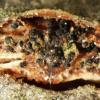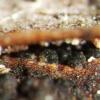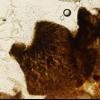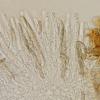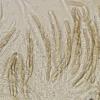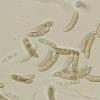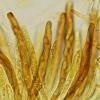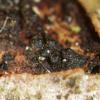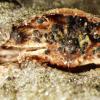
01-01-2026 18:35
Original loamy soil aside a artificial lake.The co

31-12-2025 19:27
Collected from loamy soil, at waterside (completel

30-12-2025 16:44
Pascal DucosBonjour,Une anamorphe rose stipitée, très nombre

30-12-2025 17:14
 Bernard CLESSE
Bernard CLESSE
Bonjour à toutes et tous,Pourriez-vous aider Albe

29-12-2025 10:15
Hulda Caroline HolteHello, I found and collected this propoloid ascom

30-12-2025 09:04
Hello.A Pyrenomycete sprouting sparsely but very d

29-12-2025 17:44
Isabelle CharissouBonjour,J'aimerais savoir si d'autres personnes au
Pyreno on Fagus
Gernot Friebes,
06-03-2018 10:40
this one is unknown to me and before I delve further into the literature I wanted to show it here in case someone recognizes it. It grows beneath the bark of a thin branch of Fagus sylvatica still attached to the tree; the ascomata often develop very close to some black remains of a different pyrenomycete (at least that would be my interpretation). The ascomata are non-stromatic, black, glabrous, +- broadly pyriform, sometimes partly immersed, relatively soft and collapsing when dry. The ascospores are light brown, non-septate, +- allantoid and measure about (16.8)18.4–20.9 x (3)3.8–4.4(5.4) µm. The asci do not have a visible apical apparatus (and are IKI-), the hamathecium consists of thin paraphyses.
Best wishes,
Gernot
Alain GARDIENNET,
06-03-2018 11:20
Re : Pyreno on Fagus
Hi Gernot,
I suppose, with such microscopical features, you first thought at E. quaternata. But if you are sure that it's non stromatic, that's not a good way.
Have you observed E. quaternata on the same twig ?
Alain
I suppose, with such microscopical features, you first thought at E. quaternata. But if you are sure that it's non stromatic, that's not a good way.
Have you observed E. quaternata on the same twig ?
Alain
Gernot Friebes,
06-03-2018 12:01
Re : Pyreno on Fagus
Hi, Alain,
there are certainly a number of perithecia present that are non-stromatic (see the first photo), and then there are some that grow on or very close to black "masses" that I interpret as remains of a different fungus in my initial posting. I attach another photo that illustrates that somewhat. Overall the soft and collapsing, at least partly non-stromatic ascomata lead me to belive, among other things, that this is likely not a diatrypaceous fungus, even though the +- brown, allantoid ascospores might point in that direction. I also attach a photo of the same ascomata shown in the first photo but this time in dry state (collapsed). I did not observe E. quaternata on this branch.
Best wishes,
Gernot
there are certainly a number of perithecia present that are non-stromatic (see the first photo), and then there are some that grow on or very close to black "masses" that I interpret as remains of a different fungus in my initial posting. I attach another photo that illustrates that somewhat. Overall the soft and collapsing, at least partly non-stromatic ascomata lead me to belive, among other things, that this is likely not a diatrypaceous fungus, even though the +- brown, allantoid ascospores might point in that direction. I also attach a photo of the same ascomata shown in the first photo but this time in dry state (collapsed). I did not observe E. quaternata on this branch.
Best wishes,
Gernot
Alain GARDIENNET,
06-03-2018 13:18
Re : Pyreno on Fagus
I agree with your conclusion, of course.
But I've no idea for you unfortunately.
Alain
But I've no idea for you unfortunately.
Alain
Jacques Fournier,
06-03-2018 14:27

Re : Pyreno on Fagus
Hi Gernot and Alain,
I think I don't know this fungus either and I agree it is unlikely a Diatrypaceae.
A superficial view of the necks is not much informative. In order to see the arrangement of ascomata, the possible presence of internal stromatic tissue or black lines, or presence of another fungus, the best would be a nice vertical section after having split the wood.
Best,
Jacques
I think I don't know this fungus either and I agree it is unlikely a Diatrypaceae.
A superficial view of the necks is not much informative. In order to see the arrangement of ascomata, the possible presence of internal stromatic tissue or black lines, or presence of another fungus, the best would be a nice vertical section after having split the wood.
Best,
Jacques
Gernot Friebes,
06-03-2018 14:48
Re : Pyreno on Fagus
Hi, Jacques,
I certainly agree but I fear that there is not much more that I can show. For example the ascoma encircled in the attached photo is the whole perithecium, which means that on my photos you can generally see not just the necks but actually most of the ascomata.
I will send this fungus to Hermann who will try to culture it, maybe that can lead us in the right direction!
Best wishes,
Gernot
I certainly agree but I fear that there is not much more that I can show. For example the ascoma encircled in the attached photo is the whole perithecium, which means that on my photos you can generally see not just the necks but actually most of the ascomata.
I will send this fungus to Hermann who will try to culture it, maybe that can lead us in the right direction!
Best wishes,
Gernot
Jacques Fournier,
06-03-2018 14:54

Re : Pyreno on Fagus
OK, I see what you mean, not necks but perithecia.
Sure Hermann is the right man for the job!
Jacques
Sure Hermann is the right man for the job!
Jacques
Andrew N. Miller,
07-03-2018 18:26

Re : Pyreno on Fagus
If Hermann is not interested, I'd like to culture and sequence this. I believe it may be in the Helminthosphaeriaceae and, thus, it will not grow in culture. Are there 15-20 ascomata that I could use for DNA extraction and sequencing?
Cheers,
Andy
Cheers,
Andy
Gernot Friebes,
07-03-2018 18:48
Re : Pyreno on Fagus
Thanks for your interest, Andy. I did run my fungus through your Helminthosphaeriaceae key before my initial posting because I thought that it had some similarities to a few species in this family. Maybe that actually is the right direction!
The fungus is now already on its way to Hermann. Maybe he reads this thread and can post a suggestion on how we should proceed; otherwise I will inform him directly of your reply, and I (or he) will keep you updated. There are certainly enough ascomata left for sequencing.
Best wishes,
Gernot
The fungus is now already on its way to Hermann. Maybe he reads this thread and can post a suggestion on how we should proceed; otherwise I will inform him directly of your reply, and I (or he) will keep you updated. There are certainly enough ascomata left for sequencing.
Best wishes,
Gernot
Andrew N. Miller,
07-03-2018 20:11

Re : Pyreno on Fagus
Excellent! Could be a new genus/species...
Andy
Andy
Andrew N. Miller,
13-09-2018 16:57

Re : Pyreno on Fagus
Any updates on this fungus?



